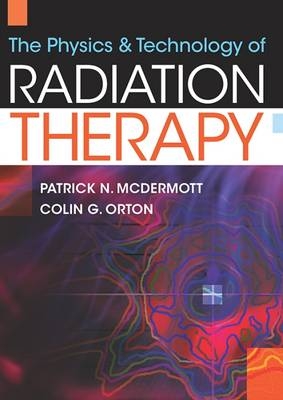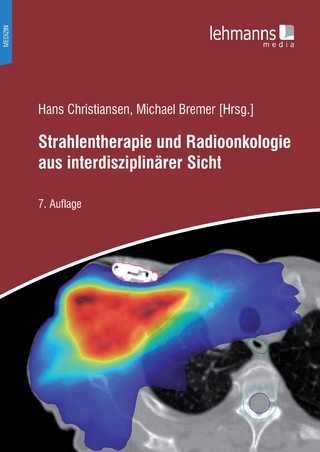
The Physics & Technology of Radiation Therapy
Medical Physics Publishing Corporation (Verlag)
978-1-930524-32-3 (ISBN)
- Titel ist leider vergriffen;
keine Neuauflage - Artikel merken
An introductory textbook to the physics and technology used in radiation therapy that is the outgrowth of a course taught to medical residents in radiation oncology and which has been classroom tested over many years. Every effort has been made to make explanations clear and simple without oversimplifying - the book has been designed to be interesting to read as well as clinically relevant. The first half of the book contains the radiation physics necessary to understand radiation therapy. The second half of the book covers the applied physics and technology of radiation therapy. Topics include: treatment machines, beam calibration, dosimetric parameters, MU calculations, dose distributions in patients, electron beams, brachytherapy, radiation safety, quality assurance, imaging, and special modalities. Features: Comprehensive end of chapter summaries; Numerous example-problems; Full problem set for each chapter with selected answers; Clinically-realistic linac dosimetry data for practice MU calculations; ABR physician board certification physics topic matrix; ARRT exam topic matrix.
Preface
Acknowledgments
Chapter 1 Mathematics Review
1.1 Exponents
1.1.1 Multiplication
1.1.2 Division
1.1.3 An Exponential Raised to a Power
1.1.4 A Product Raised to a Power
1.1.5 Base e
1.2 Logarithms
1.3 Geometry
1.4 Trigonometry Problems
Chapter 2 Review of Basic Physics
2.1 Units for Physical Quantities
2.2 Mechanics
2.2.1 Newton's Second Law
2.2.2 Work
2.2.3 Work Energy Theorem and Energy Conservation
2.2.4 Power
2.3 Electricity and Magnetism
2.3.1 Charge and the Coulomb Force
2.3.2 Electric Fields
2.3.3 Current
2.3.4 Potential Difference
2.3.5 The Electron Volt - A Unit of Energy Not Voltage
2.3.6 Magnetism
2.4 Electromagnetic Spectrum
2.5 The Special Theory of Relativity
2.6 Review of Atomic Structure Problems
Bibliography
Chapter 3 Atomic Nuclei and Radioactivity
3.1 Basic Properties of Nuclei
3.2 Four Fundamental Forces of Nature
3.3 Nuclear Binding Energy: Mass Defect
3.4 Stability of Nuclei
3.5 Antimatter
3.6 Properties of Nuclei and Particles
3.7 Radioactivity
3.8 Mathematics of Radioactive Decay
3.9 Activity
3.10 Half-Life
3.11 Mean-Life
3.12 Modes of Decay
3.12.1 Alpha Decay
3.12.2 Electromagnetic Decay
3.12.3 Beta Decay
3.13 Decay Diagrams
3.14 Radioactive Equilibrium
3.14.1 Secular Equilibrium
3.14.2 Transient Equilibrium
3.15 Production of Radionuclides
3.15.1 Fission Byproducts
3.15.2 Neutron Activation
3.15.3 Particle Accelerators
Chapter Summary
Problems
Bibliography
Chapter 4 The Production of X-Rays I: Technology
4.1 Introduction
4.2 X-Ray Tubes
4.3 Therapy X-Ray Tubes
4.4 X-Ray Film and Screens
4.5 X-Ray Generator
Chapter Summary
Problems
Bibliography
Chapter 5 X-Ray Production II: Basic Physics and Properties of Resulting X-Rays
5.1 Production of X-Rays: Microscopic Physics
5.1.1 Characteristic X-Rays
5.1.2 Bremsstrahlung Emission
5.2 X-Ray Spectrum
5.3 Efficiency of X-Ray Production
5.4 Directional Dependence of Bremsstrahlung Emission
5.5 X-Ray Attenuation
5.5.1 Beam Divergence and the Inverse-Square Effect
5.5.2 Attenuation by Matter
5.6 Half-Value Layer (HVL)
5.7 Mass Attenuation Coefficient Appendix: Röntgen and the Discovery of X-Rays
Chapter Summary
Problems
Bibliography
Chapter 6 The Interaction of Radiation with Matter
6.1 Photon Interactions With Matter
6.1.1 Coherent Scattering
6.1.2 Photoelectric Effect
6.1.3 Compton Scattering
6.1.4 Pair Production
6.1.5 Photonuclear Reactions
6.1.6 Total Mass Absorption Coefficient
6.2 Interaction of Charged Particles with Matter
6.2.1 Electron Interactions with Matter
6.2.2 Stopping Power
6.2.3 Range
6.2.4 Mean Energy To Produce An Ion Pair
6.2.5 Heavy Charged Particle Interactions and the Bragg Peak
6.3 Neutron Interactions with Matter
Chapter Summary
Problems
Bibliography
Chapter 7 Radiation Measurement Quantities
7.1 Introduction
7.2 Exposure
7.3 Charged Particle Equilibrium
7.4 Some Important Radiation Dosimetry Quantities
7.5 Dose Buildup and Skin Sparing
7.6 Absorbed Dose to Air
7.7 Dose in a Medium Calculated from Exposure
7.8 Dose In Free Space
7.9 An Example of Photon Interactions: History of a 5.0 MeV Photon in Water
7.10 Monte Carlo Calculations
7.11 Microscopic Biological Damage
Chapter Summary
Problems
Bibliography
Chapter 8 Radiation Detection and Measurement
8.1 Introduction
8.2 Phantoms
8.3 Gas Ionization Detectors
8.3.1 Ionization Chambers
8.3.2 Survey Meter Ion Chambers
8.3.3 Charge Collection and Measurement
8.3.4 Proportional Counters
8.3.5 Geiger-Müller (GM) Counter
8.3.6 Summary of Gas Ionization Detectors
8.4 Solid-State Detectors
8.4.1 Thermoluminescent Dosimeters
8.4.2 Film
8.4.3 Diodes
8.4.4 MOSFETS
8.4.5 Polymer Gels
8.5 Liquid Dosimeters
8.5.1 Calorimeters
8.5.2 Chemical Dosimetry
Chapter Summary
Problems
Bibliography
Chapter 9 External Beam Radiation Therapy Units
9.1 Introduction
9.2 Medical Electron Linear Accelerators
9.2.1 Source of Microwave Power
9.2.2 The Treatment Head
9.2.3 Linear Accelerator Auxiliary Subsystems
9.2.4 Interlocks and Safety Systems
9.2.5 Patient Support Assembly
9.3 Cobalt-60 Teletherapy Units
9.4 Cyclotrons
9.5 Photon Beam Characteristics
Chapter Summary
Problems
Bibliography
Chapter 10 Central Axis Dose Distribution
10.1 Introduction
10.2 Percent Depth Dose (PDD)
10.3 Source of Microwave Power
10.4 Tissue-Air Ratio (TAR)
10.5 Backscatter and Peak Scatter Factors
10.6 Tissue-Phantom Ratio (TPR) and Tissue-Maximum Ratio (TMR)
10.7 Equivalent Squares
10.8 Linear Interpolation
Chapter Summary
Problems
Bibliography
Chapter 11 Calibration of Megavoltage Photon Beams
11.1 Normalization Conditions
11.1.1 Normalization Conditions for Co-60
11.1.2 Normalization Conditions for Linear Accelerators
11.2 Steps in Beam Calibration
11.3 Ion Chamber Calibration
11.4 Beam Quality
11.5 The Task Group 51 Dose Equation
11.6 Calibration Conditions
11.7 An Example of TG-51 Calculations
11.8 Constancy Checks of Beam Calibration
Chapter Summary
Problems
Bibliography
Chapter 12 Calculation of Monitor Unit/Timer Setting for Open Fields
12.1 Introduction
12.2 Normalization Conditions
12.3 Head Scatter and Phantom Scatter
12.4 Dose Rate Calculations
12.4.1 Percent Depth Dose Calculations (SSD = SAD)
12.4.2 Isocentric Calculations
12.4.3 Dose Rate at an Arbitrary Distance
12.4.4 The Equivalence of PDD and TMR Calculations
Chapter Summary
Problems
Bibliography
Chapter 13 Shaped Fields
13.1 Introduction
13.2 Field Shaping Methods
13.2.1 Asymmetric Jaws
13.2.2 Blocks
13.2.3 Multileaf Collimators
13.3 Dose Rate Calculations for Shaped Fields: Symmetric Jaws, Central Axis
13.3.1 Approximate Methods for Estimating the Equivalent Square of a Blocked Field
13.3.2 Clarkson Integration
13.4 Dose Rate Calculations for Shaped Fields at Points Away from the Central Axis
13.5 Dose Rate Calculations with Asymmetric Jaws
13.6 Dose Under a Blocked Region
Chapter Summary
Problems
Bibliography
Chapter 14 Dose Distributions in Two and Three Dimensions
14.1 Isodose Charts
14.2 Skin Contour
14.2.1 Isodose Shift Method
14.2.2 Effective SSD Method
14.2.3 Ratio of TAR (rTAR) Method
14.3 Parallel-Opposed Fields
14.3.1 Adding Isodose Distributions
14.3.2 Beam Weighting
14.4 Wedges
14.4.1 Wedged Fields
14.4.2 Wedge Transmission Factor
14.4.3 Dose Rate Calculations with a Wedge Present
14.5 Multiple Beams
14.6 Dose-Volume Specification and Reporting
14.7 Evaluation of Patient Dose Distributions
14.8 Arc or Rotation Therapy
14.9 Surface Dose
14.10 Bolus
14.11 Beam Spoilers
14.12 Tissue Compensators
14.13 Tissue Inhomogeneities
14.14 Field Matching
14.15 Patient Positioning and Immobilization Devices
Chapter Summary
Problems
Bibliography
Chapter 15 Electron Beam Dosimetry
15.1 Introduction
15.2 Electron Applicators
15.3 Field Shaping
15.4 Dose Rate Calculations for Electron Beams
15.5 Internal Blocking
15.6 Isodose Curves
15.7 Inhomogeneities
15.8 Field Matching
Chapter Summary
Problems
Bibliography
Chapter 16 Brachytherapy
16.1 Introduction
16.2 Review of Radioactivity
16.3 Radioactive Sources
16.4 Brachytherapy Applicators
16.5 Source Strength and Exposure Rate Constant
16.6 Dose Rate Calculations from Exposure Rate
16.7 Specification of Source Strength
16.8 Task Group 43 Dosimetry
16.9 Accumulated Dose from Temporary and Permanent Implants
16.10 Systems of Implant Dosimetry
16.10.1 A Point Source
16.10.2 A Linear Array
16.10.3 Planar and Volume Implants
16.11 Intracavitary Treatment of Cervical Cancer
16.12 Along and Away Tables
16.13 Localization of Sources
16.14 High Dose Rate Remote Afterloaders
Chapter Summary
Problems
Bibliography
Chapter 17 Radiation Protection
17.1 Dosimetric Quantities Used for Radiation Protection
17.2 Exposure of Individuals to Radiation
17.3 Biological Effects of Radiation
17.3.1 Carcinogenesis
17.3.2 Risk to Fetus/Embryo
17.3.3 Genetic Effects
17.4 Radiation Protection Principles
17.5 NRC Regulations
17.5.1 Annual Dose Limits
17.5.2 Medical License and General Requirements
17.5.3 Written Directives and Medical Events
17.5.4 Examples of Events Reported to the NRC
17.5.5 Radiation Protection for Brachytherapy Procedures
17.5.6 NRC Safety Precautions for Therapy Units
17.6 Personnel Monitoring
17.7 Shipment and Receipt of Radioactive Packages
17.7.1 Package Labels
17.7.2 Receipt of Radioactive Packages (NRC Regulations)
17.8 Shielding Design for Linear Accelerators
17.8.1 Primary Barriers
17.8.2 Secondary Barriers
17.8.3 Neutrons
17.8.4 The Entryway
17.8.5 Radiation Protection Survey of a Linear Accelerator
Chapter Summary
Problems
Bibliography
Chapter 18 Radiation Protection
18.1 Introduction
18.2 Equipment Quality Assurance
18.2.1 Linear Accelerators
18.2.2 NRC Regulations Pertaining to QA
18.2.3 Dosimetry Instrumentation
18.3 Patient Quality Assurance
18.3.1 Physics Chart Checks
18.3.2 Weekly Physics Chart Checks
18.3.3 Portal Imaging
18.3.4 In Vivo Dosimetry
18.4 Starting New Treatment Programs
18.5 Mold Room Safety
18.6 Patient Safety
18.7 Radiation Therapy Accidents
18.7.1 A Linear Accelerator Calibration Error
18.7.2 An HDR Accident
18.7.3 Malfunction 54
18.7.4 Co-60 Overdose
Chapter Summary
Problem
Bibliography
Chapter 19 Imaging in Radiation Therapy
19.1 Introduction
19.2 Digital Images
19.3 Conventional Simulators
19.4 Computed Tomography
19.4.1 Development of CT Scanners
19.4.2 CT Image Reconstruction
19.4.3 CT Numbers and Hounsfield Numbers
19.4.4 Digitally Reconstructed Radiographs
19.4.5 Virtual Simulation
19.4.6 4D CT
19.5 Magnetic Resonance Imaging
19.6 Image Fusion/Registration
19.7 Ultrasound Imaging
19.8 Functional/Metabolic Imaging
19.9 Portal Imaging
19.9.1 Port Films
19.9.2 Electronic Portal Imaging Devices
19.10 Image-Guided Radiation Therapy
Chapter Summary
Problems
Bibliography
Chapter 20 Special Modalities in Radiation Therapy
20.1 Introduction
20.2 Intensity Modulation in Radiation Therapy
20.2.1 IMRT Delivery Techniques
20.2.2 Inverse Treatment Planning
20.2.3 Inverse Planning Issues
20.2.4 Case Study: Prostate Cancer
20.2.5 Aperture-Based Optimization
20.2.6 Physics Plan Validation
20.2.7 Whole-Body Dose and Shielding
20.3 Stereotactic Radiosurgery
20.3.1 Introduction
20.3.2 Linac-Based Radiosurgery
20.3.3 Gamma Knife
20.3.4 Imaging
20.3.5 Treatment Planning
20.3.6 Dosimetry
20.3.7 Quality Assurance
20.4 Proton Radiotherapy
20.4.1 Introduction
20.4.2 Potential Advantages of Protons
20.4.3 Proton Therapy Accelerators
20.4.4 Production and Selection of Different Energy Beams
20.4.5 Lateral Beam Spreading and Field Shaping with Protons
20.4.6 Beam-Delivery/Transport
20.4.7 Dose Calculations and Treatment Planning for Proton Therapy
20.4.8 Dose Distributions
20.4.9 Calibration of Proton Beams and Routine Quality Assurance
20.4.10 Future Developments
Chapter Summary
Problems
Bibliography
Appendix A - Board Certification Exams in Radiation Therapy
Appendix B - Dosimetry Data
Appendix C - MEVALAC Beam Data
Appendix D - Answers to Selected Problems
| Erscheint lt. Verlag | 7.2.2011 |
|---|---|
| Verlagsort | Madison, WI |
| Sprache | englisch |
| Maße | 184 x 254 mm |
| Themenwelt | Medizin / Pharmazie ► Medizinische Fachgebiete ► Onkologie |
| Medizinische Fachgebiete ► Radiologie / Bildgebende Verfahren ► Nuklearmedizin | |
| Medizinische Fachgebiete ► Radiologie / Bildgebende Verfahren ► Radiologie | |
| Naturwissenschaften ► Geowissenschaften ► Geophysik | |
| Naturwissenschaften ► Physik / Astronomie ► Angewandte Physik | |
| ISBN-10 | 1-930524-32-3 / 1930524323 |
| ISBN-13 | 978-1-930524-32-3 / 9781930524323 |
| Zustand | Neuware |
| Haben Sie eine Frage zum Produkt? |
aus dem Bereich


